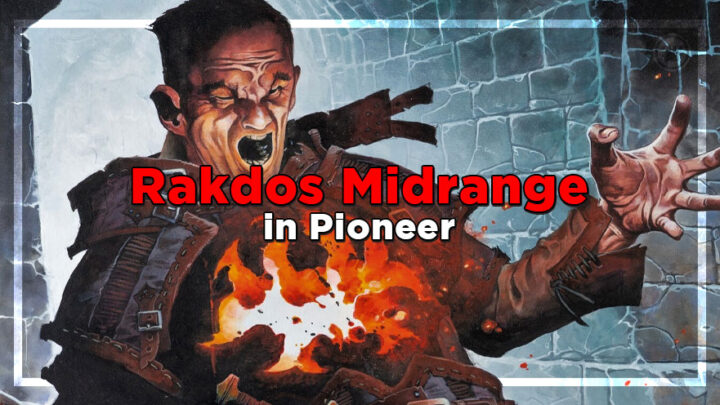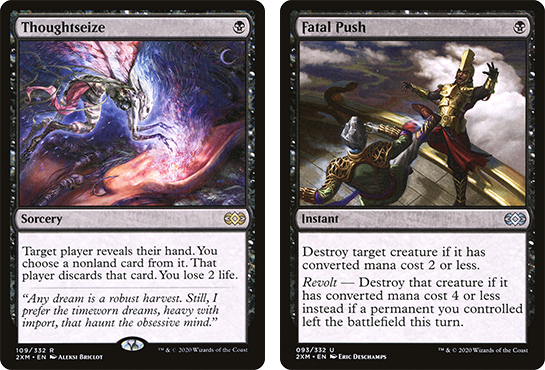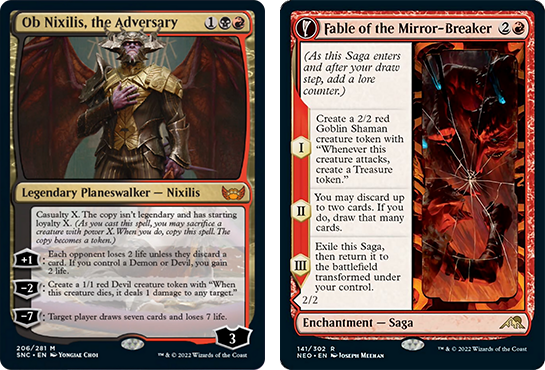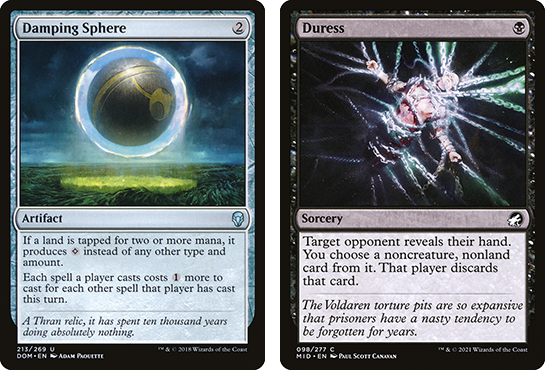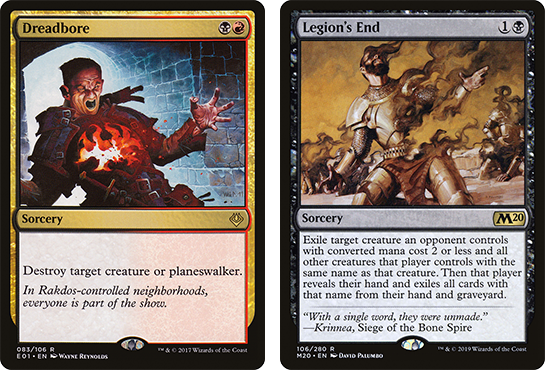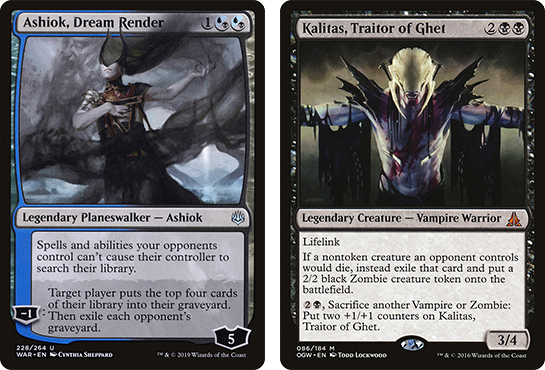Pioneer is a featured format in the return of Organized Play, and Michael’s here to take a deep dive into Rakdos Midrange decks in the format!
Pioneer was one of my favorite formats before Covid shut down paper Magic for the better part of two years. With the upcoming Pioneer PTQ season I decided to get back into things ahead of time to shake off the rust. As is predicted, I have an affinity for the Thoughtseize midrange deck. Rakdos is the premier interactive midrange deck in a format densely populated by creature decks. Today I’ll break down my take on the deck, including some updates from Streets of New Capenna!
First thing first, what is Rakdos Midrange trying to do? If you’ve ever played Modern Jund the experience is incredibly similar. The recipe is cheap threats mixed with efficient disruption, with some value engines sprinkled in. Like any other midrange deck, Rakdos’s role in any individual game is going to fluctuate as the game progresses. There are going to be some matchups where Rakdos needs to get aggressive with Bloodtithe Harvester and Tenacious Underdog, but others where playing as a control deck is needed.
Interaction
Part of any good midrange deck is the suite of interactive cards. Rakdos doesn’t have access to counterspells, which means that discard spells and board control are the focus here.
Four copies of Thoughtseize is a staple of black midrange decks across multiple formats. For a single black mana you get to strip the opponent’s best card before it ever hits the table. Sometimes Thoughtseize simply blows a hole in the opposing curve, or overall gameplan, giving Rakdos time to set up an insurmountable advantage. Additionally, the information gained from Thoughtseize can’t be overstated, as having knowledge of the opponent’s hand gives you the upper hand in planning where the game needs to go.
Fatal Push is the gold standard for cheap removal. One mana and instant speed are both fantastic qualities. Fatal Push scales well into the later parts of the game as if you have a blood token, treasure token, Fabled Passage, Kroxa, or a token from Reflection of Kiki-Jiki, you can turn on revolt to be able to kill opposing three- and four-mana creatures. Winota, Joiner of Forces is one of the premier threats in Pioneer, so having access to instant speed ways to answer it is of high importance.
Dreadbore is a card that I see a lot of copies of in many Rakdos decks. I don’t necessarily think this is correct, as I’m not sure I want three or more copies in the main deck. Will Dreadbore kill whatever you need it to? Yes, that is where the value lies, any creature or planeswalker you want dead, is dead. The drawback of being a sorcery is steep, as we just covered with Fatal Push, being able to kill Winota at instant speed is important, and Dreadbore can’t do that. Answering planeswalkers, or not needing to operate at instant speed in other matchups is still important, which is why I’ve moved the third copy to the sideboard.
Infernal Grasp isn’t the ideal card for this slot, but Pioneer has a noticeable lack of main deck playable instants that kill Winota. So until something gets printed that is closer to Terminate I’ve got to work with what I’ve got. Infernal Grasp is exactly that, it is an instant that will always kill Winota before the opponent gets to attack, and that alone earns it a starting spot. Two-mana removal spells beyond Dreadbore certainly aren’t stock, but without Bonecrusher Giant I was feeling a bit light on removal overall, so I decided to beef up the removal suite a bit.
Threats
Bloodtithe Harvester is a multi-talented vampire! A two mana 3/2 is already a decent body in Pioneer, but Bloodtithe Harvester also enters with a blood token, which has its own myriad of uses. The text on this card keeps going; Bloodtithe Harvester can also be a removal spell if you have some extra blood lying around. Bloodtithe Harvester can even be sacrificed to Kalitas in a pinch! I don’t think Rakdos could ask for a more tailored two-mana creature. Bloodtithe Harvester just does it all.
Tenacious Underdog is the newest addition to the team, and it isn’t wasting any time making an impact. Like Bloodtithe Harvester, Tenacious Underdog has a reasonable 3/2 body, which is important because Rakdos now has eight copies of a two-mana 3/2 to curve into Ob Nixilis, the Adversary. Maybe this is a bit too ambitious of a take, but Tenacious Underdog fills a similar role to Dark Confidant, but on a Pioneer power level. While you’ll frequently play Underdog on turn two as a 3/2, the real power is the blitz ability. A recursive haste 3/2 that also draws a card when it dies is going to take over a lot of games where playing the control role is important. Combining pressure with card advantage is hard to do in formats with smaller card pools, but Tenacious Underdog fills that role well, and supplants Chandra, Torch of Defiance in my mind.
Speaking of combining pressure with card advantage, Kroxa, Titan of Death’s Hunger is among the best options in Pioneer. While Kroxa won’t generate cards for you, it will strip opposing cards, creating virtual card advantage. Kroxa earns its money in the midrange mirror where removal is prevalent and having the last threat on the board is important. Kroxa will easily and single handedly take over the game in Rakdos mirrors, and against other slow decks like Azorius Control. Blood tokens and Fable of the Mirror-Breaker make it easy to get a Kroxa in the graveyard if you draw it later, or it simply doesn’t fit into the curve of that game.
Graveyard Trespasser combines a reasonable 3/3 body with resilience from the ward ability (which guarantees a two-for-one), main deck playable graveyard hate, and incidental life gain. These small things really add up in a format with Arclight Phoenix, Kroxa, Parhelion II, and aggressive creature decks. Graveyard Trespasser may look meek if you just read the card, but it plays out much better than it looks, and I’m continuously surprised how good it is.
Kalitas, Traitor of Ghet is a knockout blow against creature decks if you get to untap with it. A 3/4 lifelinker is already a stonewall against many of the creature decks in Pioneer, but tack on the fact that Kalitas can sacrifice zombies and vampires to grow will quickly put the game out of reach for anyone looking to win by attacking. Removal spells turning into “destroy your creature, I’ll make a 2/2” will swing a board into your favor in a hurry. Yet again, incidental graveyard hate is back with Kalitas, which is one of the only ways to permanently deal with a Kroxa, Tenacious Underdog, or Arclight Phoenix. However, Kalitas is four mana and legendary, so it is difficult to play too many copies in the main deck.
Value
Ob Nixilis, the Adversary is a new addition from Streets of New Capenna that thus far has proved to be incredibly powerful. The two clear homes are in Rakdos Midrange and Rakdos Sacrifice. However, I don’t think existing Rakdos Midrange decks were the best at supporting Ob Nixilis. Tenacious Underdog plays extremely well with Ob; curving Underdog on turn two, attack with Underdog on turn three, then sacrifice it to Ob’s casualty, with the possibility of blitzing Underdog from the graveyard on turn four is a powerful sequence. Having access to two planeswalkers for three mana puts an incredible amount of pressure on the opponent. Two copies of Ob with three loyalty lets you make two devil tokens if you need to defend the board, but the most common play pattern is making one devil, and plus the other copy. In matchups like Lotus Field or Jeskai Ascendancy where your life total doesn’t matter much you can turn up the pressure by using the +1 on both copies. In my experience, Ob operates as “deal four damage to your opponent each turn” until it starts running them out of cards, and then the game ends quickly from there. Building to support Ob Nixilis has been fruitful so far, and I would expect Ob to be a staple for the foreseeable future.
Fable of the Mirror-Breaker is also a relatively new addition coming from Kamigawa: Neon Dynasty. If you have time, Fable is going to out-value most cards in Pioneer, and it is just three mana. Making a 2/2 that makes a treasure token when it attacks means that you’re unlikely to fall behind on the board, which is historically a problem with cards like this. The second chapter filters dead cards into fresh ones; maybe you have too many removal spells, or lands, and you need to find pressure – Fable is there for you. Fable’s second chapter is also a nice way to both easily get Kroxa in the graveyard or feed one that is already there. The back side of Fable of the Mirror-Breaker, Reflection of Kiki-Jiki can easily take over the game. Making copies of Bloodtithe Harvester or the goblin token from the front side of Fable will both leave you with extra material once the creature dies. Bloodtithe Harvester is particularly nice because once you start stacking up blood tokens, the copies are just Terminates. Token copies can also be sacrificed to Ob Nixilis so that you don’t even need to give up any board presence!
Utility Lands
Lands are often the most understated part of any Magic deck, but Rakdos is full-up with lands that do more than just tap for mana. When the game plan is to trade one-for-one with your opponent for a while, having lands that can apply pressure or draw cards is invaluable.
Den of the Bugbear is one of the scariest lands in Pioneer, because if you’re playing the control role, booting up Den of the Bugbear is going to let you turn the corner in a hurry. Den can also prey on decks with too much sorcery speed removal, such as Azorius Control which greatly struggles to get Den off the board, making it an excellent game plan.
Hive of the Eye Tyrant has all the benefits of Den of the Bugbear when it comes to dodging sorcery speed removal and being a threat that comes into the game later once players have both exhausted resources. Hive of the Eye Tyrant is also additional main-deck-playable graveyard hate, which comes up more than I thought it would. Menace makes Hive hard to block given how much removal it is backed up by. It is tough for opponents to have two creatures with favorable blocks by the time you’re rumbling with Hive.
Takenuma, Abandoned Mire is a nice one-of to have access to in the late game. When both players are out of resources, picking up an Ob Nixilis or Kalitas is going to win a lot of games. The upside to Takenuma is that it is also an untapped black land when you need it to be. However, because Takenuma only makes black mana, it is challenging to play more than one. But I am happy to have the first copy.
Sokenzan, Crucible of Defiance is in the same boat as Takenuma about its restrictions, and in that it is a land when you need it and a spell when you don’t. Sokenzan making creatures at instant speed can make combat a nightmare. Azorius Control opponents also need to worry about using the -3 ability on Teferi, Hero of Dominaria, because Sokenzan is happy to punish that decision, easily killing the Teferi with two haste 1/1s.
Castle Locthwain used to be a solid two-of in just about every black deck in Pioneer. I’ve been less impressed by it lately. Since the mana base has moved toward Pathways and Haunted Ridge, Castle Locthwain enters tapped more than it used to. Additionally, thanks to Tenacious Underdog, Rakdos isn’t hurting for ways to draw cards with the extra mana it may have. However, I like having access to one for the moment just to add a bit of redundancy for the slower matchups.
Urborg, Tomb of Yawgmoth really ties the whole mana base together. Rakdos does have some challenging mana requirements depending on the exact build, and Urborg does a lot to fix that. Playing Mountain, and multiple copies of Den of the Bugbear feels significantly less bad when Urborg is involved. Turning Searstep Pathway into Badlands is nothing to scoff at either. I’m always happy to have one copy.
Fabled Passage has been left out of a majority of Rakdos lists lately, when it used to see play in upwards of three copies. Personally, I like the added revolt enabler for Fatal Push, given how important killing Winota is. However, I don’t play enough basics to justify playing more than one copy now.
Sideboard
Through my testing this far, I’ve found that Rakdos feels good or better against almost everything but Winota, Lotus Field, and Green Devotion, which led me to stack my sideboard for those matchups.
I’m not in love with Damping Sphere against Lotus Field because they have access to Boseiju, Who Endures, Otawara, Soaring City, and Blast Zone, all of which are searchable with Sylvan Scrying. However, I do believe that you can’t go into the Lotus Field matchup with “oops all three-mana” sideboard cards. Sphere gets the nod largely because it is two mana, which makes it harder for them to answer with Blast Zone, compared to Alpine Moon. Damping Sphere is also playable against Phoenix, and strong against Jeskai Ascendancy.
Duress is another point of disagreement that I have with other builds of Rakdos. I frequently see three or four copies of Duress in Rakdos sideboards, and it just doesn’t seem to do enough. Against the combo decks, Rakdos is infrequently fast enough to kill the opponent before they can recover from a discard spell or two. However, I don’t want all of my combo hate stuck at the same mana value, so I opted to add a Duress to buy some time for me to get an Ashiok, Dream Render in play. Duress is also better than it looks against Winota, because it can snag Esika’s Chariot and Fable of the Mirror-Breaker, both of which can be tricky to beat.
Dreadbore gets a sideboard slot instead of any of the other Terminate variants largely because of Green Devotion. While Green Devotion certainly can run you over with creatures, they frequently win with planeswalkers, and Dreadbore covers both angles. Dreadbore is going to come in against basically all of the creature decks because I’ll frequently be the control deck in those matchups, and against planeswalker heavy strategies like Azorius Control.
Legion’s End is great at cleanly answering Voice of Resurgence, which is a big selling point for a sideboard removal spell, given how miserable it is to try and kill a Voice otherwise. Legion’s End will also clean up any tokens that you might run into, as well as the multiple-mana-elves draws from Winota or Green Devotion. Mono Red and Boros Heroic will often have multiple of the same small creature as well, which is just added value for Legion’s End
Noxious Grasp is an essential sideboard card now. Often players will have Ray of Enfeeblement in this slot to kill Winota, but Noxious Grasp is significantly less narrow. Instead of only killing a couple of creatures in the Winota deck like Ray of Enfeeblement, Noxious Grasp kills every creature in their deck, as well as answering everything in the Green Devotion decks (except for Karn, the Great Creator). Mono White Devotion has popped up every now and then as well, and Noxious Grasp is also excellent in that matchup. I even like a few copies against Azorius Control as it kills The Wandering Emperor, Teferi, Hero of Dominaria, and Yorion, Sky Nomad.
Go Blank shines mostly against Phoenix to try and keep them low on cards while exiling their graveyard, which can sometimes catch an Arclight Phoenix stuck in the graveyard in the early stages of the game. Turning off Treasure Cruise and Temporal Trespass is also buying you a lot of time to set up your aggression to be able to end the game before they can combo kill you. Go Blank will often come in against the Kroxa mirrors to try and snipe a Kroxa out of the graveyard before it can become a problem later in the game.
Ashiok, Dream Render is perhaps one of the best cards against Lotus Field. My issue with Alpine Moon and Damping Sphere is that they are too easily answered by Blast Zone, Otawara, Soaring City, and Boseiju, Who Endures, all of which can be found with Sylvan Scrying. Not only does Ashiok dodge Boseiju, but it prevents the opponent from searching for their other answers with Sylvan Scrying. Lotus Field thrives off the ability to tutor for their combo pieces with Emergent Ultimatum, Mastermind’s Acquisition, and Behold the Beyond, so shutting off all these cards makes it unlikely that they can find everything they need before you can end the game.
An extra copy of Kalitas, Traitor of Ghet is just a hedge to the creature decks. Three copies I believe is the sweet spot in those matchups, because you don’t usually want to draw a second one but you really want to find the first copy.
That is all that I have for this week, but as always, I am thrilled to be able to talk about some of my favorite decks in a sweet format that is just getting back onto its feet in time for a PTQ season that I’m sure will be a blast! Hopefully this provided some insight on what I think is important when building your own Rakdos Midrange deck. As always, I am available on Twitter at @RappaciousOne for any questions, comments, or feedback. I’ll see everyone back here next Friday!
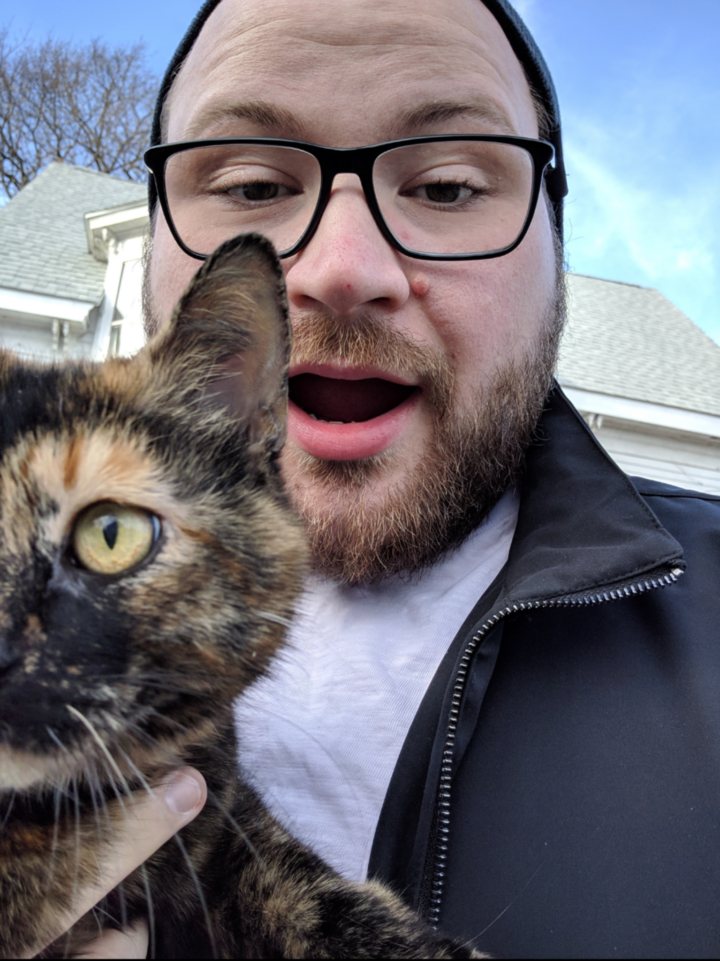
Michael Rapp is a Modern specialist who favors Thoughtseize decks. Magic sates his desire for competition and constant improvement.

